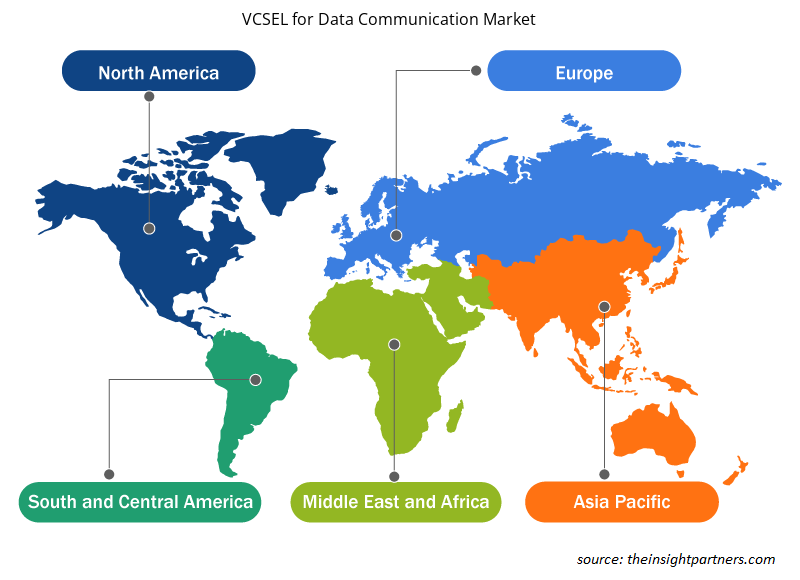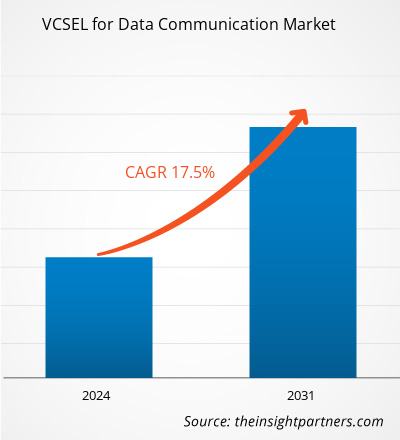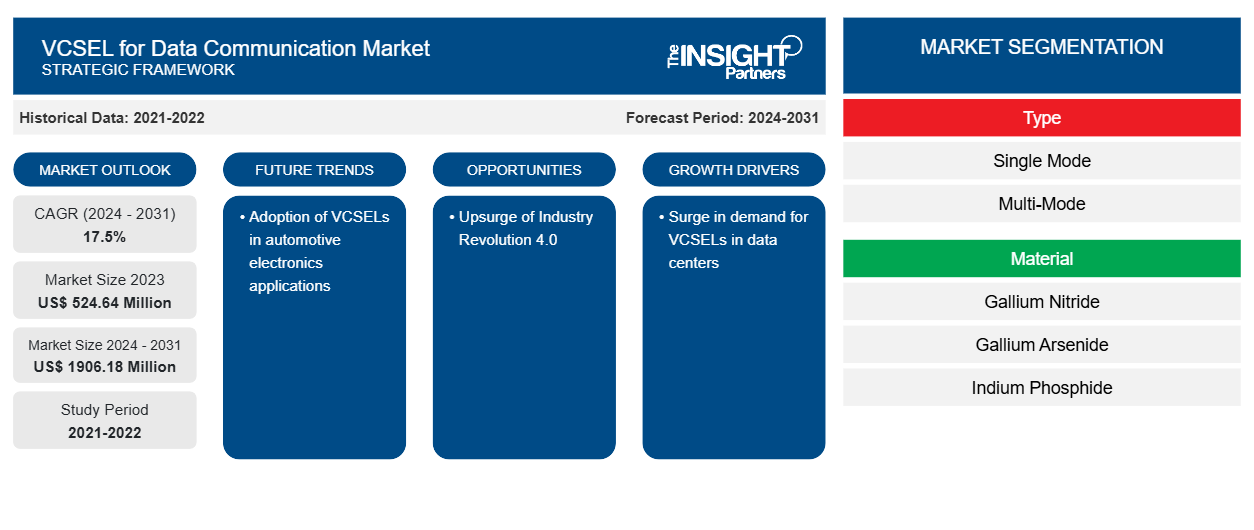Si prevede che il mercato dei VCSEL per la comunicazione dati crescerà da 524,64 milioni di $ USA nel 2023 a 1906,18 milioni di $ USA entro il 2031; si prevede che si espanderà a un CAGR del 17,5% dal 2024 al 2031. L'adozione di VCSEL nelle applicazioni elettroniche per autoveicoli rimarrà probabilmente un VCSEL chiave per le tendenze del mercato della comunicazione dati.
Analisi del mercato VCSEL per la comunicazione dati
L'ascesa della rivoluzione industriale 4.0, che comprende tecnologie come l'automazione, l'intelligenza artificiale e l'Internet of Things (IoT), ha contribuito alla crescita del VCSEL per il mercato della comunicazione dati.
Panoramica del mercato VCSEL per la comunicazione dati
Un laser a emissione superficiale a cavità verticale (VCSEL) è un diodo laser basato su semiconduttore che produce un potente raggio laser verticalmente dalla sua superficie superiore. Questi dispositivi hanno guadagnato popolarità in una varietà di settori, in particolare per le applicazioni di rete. I VCSEL hanno una gamma di lunghezze d'onda da 850 nm a 1310 nm e possono trasportare dati a velocità che vanno da 2,125 Gbps a 150 Gbps. Forniscono un mix distinto di elevata densità di potenza, piccolo packaging, ampiezza spettrale stretta e funzionamento rapido. Rispetto ai tipici diodi laser, i VCSEL sono meno influenzati dalle variazioni di temperatura. La stragrande maggioranza dei VCSEL disponibili in commercio funziona a 850 nm ed è progettata in modo particolare per soddisfare i severi requisiti della trasmissione dati ad alta velocità
Personalizza questo report in base alle tue esigenze
Riceverai la personalizzazione gratuita di qualsiasi report, comprese parti di questo report, o analisi a livello nazionale, pacchetto dati Excel, oltre a usufruire di grandi offerte e sconti per start-up e università
-
Scopri le principali tendenze di mercato in questo rapporto.Questo campione GRATUITO includerà analisi di dati che spaziano dalle tendenze di mercato alle stime e alle previsioni.
Driver e opportunità di mercato per VCSEL per la comunicazione dati
Aumento della domanda di VCSEL nei data center per favorire il mercato
I data center sono componenti essenziali dell'infrastruttura Internet, che fungono da punti di accesso ai dati, di elaborazione e di archiviazione. La necessità di VCSEL nei data center è in aumento, alimentando l'espansione del mercato VCSEL per la comunicazione dati. I VCSEL sono utilizzati nei data center per una varietà di scopi, tra cui trasferimento dati ad alta velocità, interconnessioni ottiche e rilevamento. Hanno velocità dati elevate, basso consumo energetico e dimensioni ridotte, il che li rende ideali per le operazioni dei data center. Diversi motivi contribuiscono all'aumento della domanda di VCSEL nei data center. Una delle cause principali è l'espansione di Internet e la crescente necessità di capacità di elaborazione e archiviazione dati.
L'impennata della rivoluzione industriale 4.0
L'avvento di Industry Revolution 4.0 ha portato a sostanziali progressi in tecnologie come l'automazione, l'intelligenza artificiale e l'Internet of Things (IoT). Queste tecnologie hanno avuto un'influenza significativa su una varietà di settori, tra cui il business della trasmissione dati VCSEL. Industry 4.0, nota anche come Quarta Rivoluzione Industriale, si distingue per l'integrazione di sistemi digitali, fisici e biologici. Comporta l'utilizzo di tecnologie innovative per sviluppare fabbriche intelligenti e ottimizzare i processi di produzione. Uno degli obiettivi principali di Industry 4.0 è raggiungere l'ottimizzazione della produzione abilitata da IoT nelle fabbriche intelligenti. Ciò implica che apparecchiature, dispositivi e sistemi siano connessi e interagiscano tra loro tramite Internet, consentendo la raccolta e l'analisi dei dati in tempo reale.
Analisi della segmentazione del rapporto di mercato VCSEL per la comunicazione dati
Segmenti chiave che hanno contribuito alla derivazione del tipo e del materiale dell'analisi di mercato VCSEL per la comunicazione dati.
- In base al tipo, il mercato è diviso in monomodale e multimodale. Il segmento multimodale ha detenuto una quota di mercato maggiore nel 2023.
- In base al materiale, il mercato è diviso in nitruro di gallio, arseniuro di gallio, fosfuro di indio e altro. Il segmento dell'arseniuro di gallio ha detenuto una quota di mercato maggiore nel 2023.
Analisi della quota di mercato di VCSEL per la comunicazione dati per area geografica
L'ambito geografico del report di mercato VCSEL per la comunicazione dati è suddiviso principalmente in cinque regioni: Nord America, Asia Pacifico, Europa, Medio Oriente e Africa e Sud America/Sud e Centro America. Il Nord America ha dominato il mercato VCSEL per la comunicazione dati nel 2023. Il Nord America ha assistito all'innovazione nelle tecnologie avanzate, che ha contribuito alla crescita del mercato VCSEL per la comunicazione dati nella regione. Inoltre, la crescente domanda di applicazioni di comunicazione dati ha alimentato la crescita del mercato VCSEL in Nord America. I data center, in particolare, hanno guidato la domanda di VCSEL, in quanto sono una componente cruciale dell'infrastruttura Internet per l'archiviazione, l'elaborazione e l'accesso ai dati.
VCSEL per il mercato della comunicazione dati: approfondimenti regionali
Le tendenze regionali e i fattori che influenzano il mercato VCSEL per la comunicazione dati durante il periodo di previsione sono stati ampiamente spiegati dagli analisti di Insight Partners. Questa sezione discute anche i segmenti e la geografia del mercato VCSEL per la comunicazione dati in Nord America, Europa, Asia Pacifico, Medio Oriente e Africa e America centrale e meridionale.

- Ottieni i dati specifici regionali per VCSEL per il mercato della comunicazione dati
Ambito del rapporto di mercato VCSEL per la comunicazione dati
| Attributo del report | Dettagli |
|---|---|
| Dimensioni del mercato nel 2023 | 524,64 milioni di dollari USA |
| Dimensioni del mercato entro il 2031 | 1906,18 milioni di dollari USA |
| CAGR globale (2024 - 2031) | 17,5% |
| Dati storici | 2021-2022 |
| Periodo di previsione | 2024-2031 |
| Segmenti coperti |
Per tipo
|
| Regioni e Paesi coperti |
America del Nord
|
| Leader di mercato e profili aziendali chiave |
|
Densità degli attori del mercato: comprendere il suo impatto sulle dinamiche aziendali
Il mercato VCSEL per Data Communication Market sta crescendo rapidamente, spinto dalla crescente domanda degli utenti finali dovuta a fattori quali l'evoluzione delle preferenze dei consumatori, i progressi tecnologici e una maggiore consapevolezza dei vantaggi del prodotto. Con l'aumento della domanda, le aziende stanno ampliando le loro offerte, innovando per soddisfare le esigenze dei consumatori e capitalizzando sulle tendenze emergenti, il che alimenta ulteriormente la crescita del mercato.
La densità degli operatori di mercato si riferisce alla distribuzione di aziende o società che operano in un particolare mercato o settore. Indica quanti concorrenti (operatori di mercato) sono presenti in un dato spazio di mercato in relazione alle sue dimensioni o al valore di mercato totale.
Le principali aziende che operano nel mercato VCSEL per la comunicazione dati sono:
- Larghezza di banda10
- Società per azioni Broadcom, Inc.
- Fotonica di Hamamatsu KK
- Coerente
- Operazioni Lumentum LLC
- TRUMPF
Disclaimer : le aziende elencate sopra non sono classificate secondo un ordine particolare.

- Ottieni la panoramica dei principali attori del mercato VCSEL per la comunicazione dati
Notizie e sviluppi recenti del mercato VCSEL per la comunicazione dati
Il mercato VCSEL per la comunicazione dati viene valutato raccogliendo dati qualitativi e quantitativi dopo la ricerca primaria e secondaria, che include importanti pubblicazioni aziendali, dati associativi e database. Di seguito è riportato un elenco degli sviluppi nel mercato:
- Ad agosto 2023, VI Systems, in collaborazione con la Ruhr University di Bochum, l'Institute of Electronics, Computer, and Telecommunication Engineering di Torino e la Warsaw University of Technology, ha presentato l'ultima generazione di laser a emissione superficiale verticale (VCSEL) da 850 nm alla International Conference on Transparent Optical Networks (ICTON) di Bucarest, Romania. Questi VCSEL sono in grado di modulare l'intensità a larghezze di banda fino a circa 75 GHz.
(Fonte: VI Systems, Comunicato stampa, 2023)
Copertura e risultati del rapporto di mercato VCSEL per la comunicazione dati
Il rapporto "Dimensioni e previsioni del mercato VCSEL per la comunicazione dati (2021-2031)" fornisce un'analisi dettagliata del mercato che copre le seguenti aree:
- Dimensioni e previsioni del mercato a livello globale, regionale e nazionale per tutti i segmenti di mercato chiave coperti dall'ambito
- Dinamiche di mercato come fattori trainanti, vincoli e opportunità chiave
- Principali tendenze future
- Analisi dettagliata delle cinque forze PEST/Porter e SWOT
- Analisi di mercato globale e regionale che copre le principali tendenze di mercato, i principali attori, le normative e gli sviluppi recenti del mercato
- Analisi del panorama industriale e della concorrenza che copre la concentrazione del mercato, l'analisi della mappa di calore, i principali attori e gli sviluppi recenti
- Profili aziendali dettagliati
- Analisi storica (2 anni), anno base, previsione (7 anni) con CAGR
- Analisi PEST e SWOT
- Valore/volume delle dimensioni del mercato - Globale, Regionale, Nazionale
- Industria e panorama competitivo
- Set di dati Excel
Report recenti
Rapporti correlati
Testimonianze
Motivo dell'acquisto
- Processo decisionale informato
- Comprensione delle dinamiche di mercato
- Analisi competitiva
- Analisi dei clienti
- Previsioni di mercato
- Mitigazione del rischio
- Pianificazione strategica
- Giustificazione degli investimenti
- Identificazione dei mercati emergenti
- Miglioramento delle strategie di marketing
- Aumento dell'efficienza operativa
- Allineamento alle tendenze normative























 Ottieni un campione gratuito per - VCSEL per il mercato della comunicazione dati
Ottieni un campione gratuito per - VCSEL per il mercato della comunicazione dati